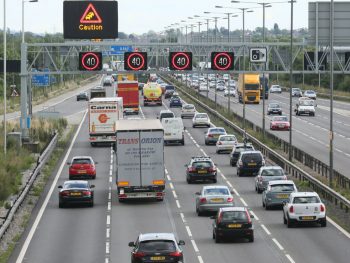Drivers afraid to use extra lane on smart motorways
The benefits of ‘all lane running’ smart motorways are being negated by drivers too scared to use the extra lane provided.

Half of drivers (49%) say they frequently or occasionally avoid using lane one on all lane running smart motorways
Half of drivers (49%) questioned by the RAC said they frequently or occasionally avoid using lane one on such motorways – effectively undoing the work to turn hard shoulders into permanent running lanes to increase road capacity.
The study, carried out with 1,904 drivers who have driven on all lane running smart motorways, found that a fifth (21%) claimed to have frequently steered clear of the left-hand inside lane while 28% admitted to doing so occasionally.
The majority (68%) of drivers also said they regularly saw other motorists doing the same – while 20% said they saw this sometimes and 5% very occasionally.
Three-quarters (77%) of those drivers avoiding lane one said they feared encountering a stationary vehicle due to the lack of a hard shoulder while 40% are afraid they will be crashed into if they stop in the inside lane.
But 52% of drivers thought the inside-most lane on all lane running motorways was mostly used by HGVs and would lead to them frequently having to overtake. Similarly, 38% say traffic in lane one is usually going much slower than 70mph and one-in-five (22%) state it is usually too congested so it’s easier to stick in another lane. A further 18% claim it’s just ‘easier’ to drive in lanes two, three and four.
The research also quizzed drivers on what could be done to improve safety on ‘all lane running’ smart motorways. Three-quarters (74%) said they would feel safer if there were more refuge areas while 72% would be reassured by technology that detects stranded vehicles and 56% want to see more gantry signs which show the speed limit and whether lanes ahead are closed. A total of 56% also want cameras to be used to enforce the ‘red X’ closed-lane signs, something which is only just beginning despite almost all cameras having been ready to do this since April this year.
Almost half (45%) believe more control centre staff monitoring these roads are needed and more than a third (37%) would like to see more National Highways patrol officers up and down the carriageways.
But 15% of those surveyed said nothing can be done to make them feel safer.
The Transport Committee held an inquiry on smart motorways last year, which saw a damning report into ALR smart motorways published in November 2021, saying they should never have been rolled out without work on safety concerns and that the DfT and National Highways (previously Highways England) had failed to deliver on promises to implement safety improvements.
Following this, the Department for Transport and National Highways agreed in January to pause the roll-out of new ALR schemes until five years of safety and economic data is available.
In the last year, National Highways, which is responsible for England’s major roads, has pressed ahead with work to improve safety measures on existing stretches of smart motorway.
It now has 122 enforcement cameras automatically detecting vehicles which ignore red-X lane-closed signs which are displayed when there is an incident in the lane ahead. The organisation is also rolling out radar technology to help identify stopped or broken-down vehicles on all lane running smart motorways more quickly and effectively.
However, separate research for the 2022 RAC Report on Motoring shows drivers are still not happy with all lane running motorways.
A clear majority of drivers (70%) want them to be scrapped in favour of schemes where a hard shoulder can be opened and closed according to how much traffic there is. Just 7% want to see further all lane running schemes rolled out, with a quarter (23%) undecided at to which configuration is best.
RAC road safety spokesperson Simon Williams said: “Motorists know they should always drive in the left-most lane they can, but with so many feeling theirs and their passengers’ lives are in jeopardy, it’s going to be very hard to convince them otherwise no matter how much extra safety technology is introduced.
“Stopped vehicle detection cameras are a definite step in the right direction, but they still require National Highways staff to check the carriageway and switch on the ‘red X’ closed-lane signs. Then drivers have to be fortunate enough to see them on gantries or signs – which are often up to 1km apart – in the first place, and hope that all other motorists obey them by moving to another lane. That’s a lot of separate things that have to happen in order to help protect a driver who has broken down, all of which are only necessary because of the decision to remove hard shoulders.”
He added: “We strongly urge the Government to abandon all lane running smart motorways and switch to ‘dynamic hard shoulders’ so that drivers can still benefit from increased road capacity at busy times while having somewhere to stop in relative safety in an emergency at other times.”















